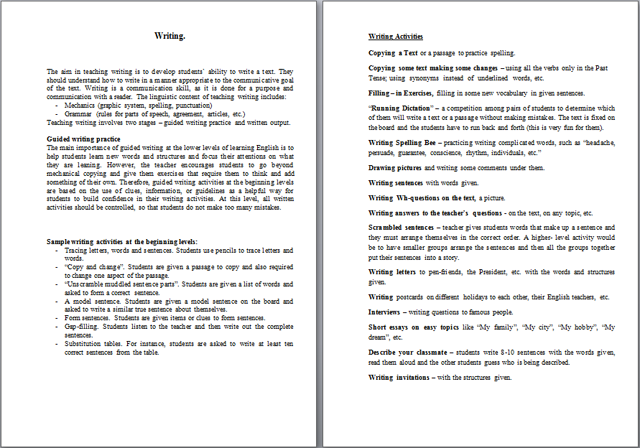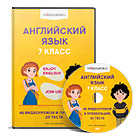Writing.
The aim in teaching writing is to develop students` ability to write a text.
They should understand how to write in a manner appropriate to the communicative goal of the text. Writing is a communication skill, as it is done for a purpose and communication with a reader. The linguistic content of teaching writing includes:
Mechanics (graphic system, spelling, punctuation)
Grammar (rules for parts of speech, agreement, articles, etc.)
Teaching writing involves two stages – guided writing practice and written output.
Guided writing practice
The main importance of guided writing at the lower levels of learning English is to help students learn new words and structures and focus their attentions on what they are leaning.
However, the teacher encourages students to go beyond mechanical copying and give them exercises that require them to think and add something of their own.
Therefore, guided writing activities at the beginning levels are based on the use of clues, information, or guidelines as a helpful way for students to build confidence in their writing activities. At this level, all written activities should be controlled, so that students do not make too many mistakes.
Sample writing activities at the beginning levels:
Tracing letters, words and sentences. Students use pencils to trace letters and words.
“Copy and change”. Students are given a passage to copy and also required to change one aspect of the passage.
“Unscramble muddled sentence parts”. Students are given a list of words and asked to form a correct sentence.
A model sentence. Students are given a model sentence on the board and asked to write a similar true sentence about themselves.
Form sentences. Students are given items or clues to form sentences.
Gap-filling. Students listen to the teacher and then write out the complete sentences.

Substitution tables. For instance, students are asked to write at least ten correct sentences from the table.
Writing Activities.
Copying a Text or a passage to practice spelling.
Copying some text making some changes – using all the verbs only in the Past Tense; using synonyms instead of underlined words, etc.
Filling – in Exercises, filling in some new vocabulary in given sentences.
“Running Dictation” – a competition among pairs of students to determine which of them will write a text or a passage without making mistakes. The text is fixed on the board and the students have to run back and forth (this is very fun for them).
Writing Spelling Bee – practicing writing complicated words, such as “headache, persuade, guarantee, conscience, rhythm, individuals, etc.”
Drawing pictures and writing some comments under them.
Writing sentences with words given.
Writing Wh-questions on the text, a picture.
Writing answers to the teacher`s questions - on the text, on any topic, etc.
Scrambled sentences – teacher gives students words that make up a sentence and they must arrange themselves in the correct order. A higher- level activity would be to have smaller groups arrange the sentences and then all the groups together put their sentences into a story.
Writing letters to pen-friends, the President, etc. with the words and structures given.
Writing postcards on different holidays to each other, their English teachers, etc.
Interviews – writing questions to famous people.
Short essays on easy topics like “My family”, “My city”, “My hobby”, “My dream”, etc.
Describe your classmate – students write 8-10 sentences with the words given, read them aloud and the other students guess who is being described.
Writing invitations – with the structures given.
Весь материал - в документе.

 Получите свидетельство
Получите свидетельство Вход
Вход












 Методическая памятка для учителей по развитию письменных навыков при обучении английскому языку (14.54 КB)
Методическая памятка для учителей по развитию письменных навыков при обучении английскому языку (14.54 КB)
 0
0 424
424 41
41 Нравится
0
Нравится
0


